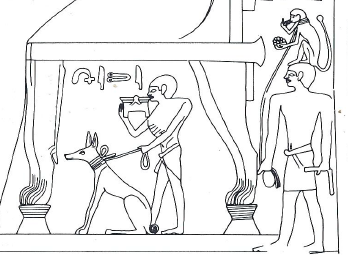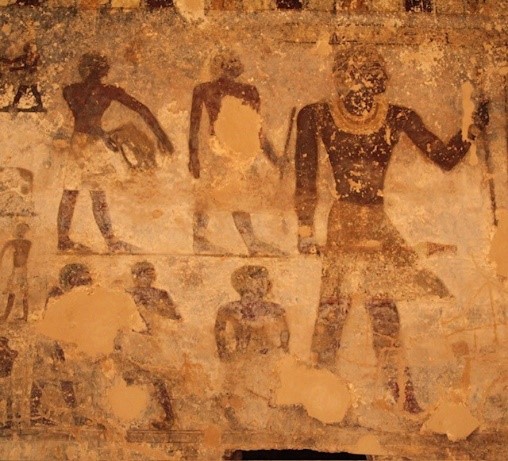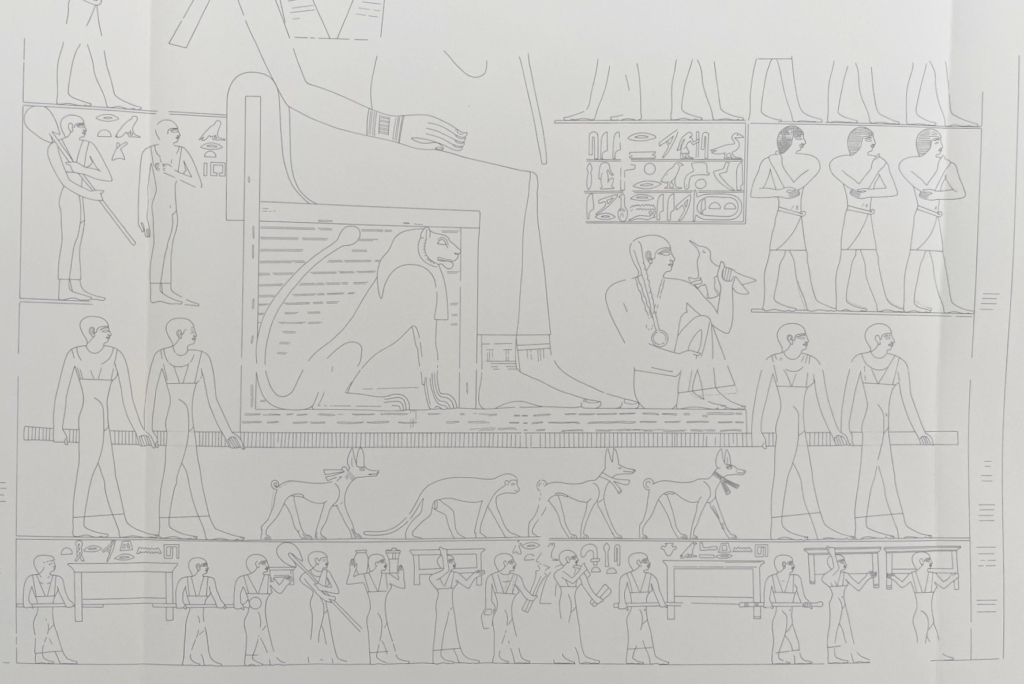‘Imperfect’ Humans and their Representation in Egyptian Tomb Decoration
In Egyptian tomb decoration, human figures are usually represented in their prime with near perfect physical features of eternal youth. However, several examples dated to the Old and Middle Kingdoms, depict ‘imperfect’ figures with physical deformities and abnormalities and occasionally name the individual represented.
In the Sixth Dynasty tomb of Nikauisesi in Saqqara, a man identified as the seal bearer, Itji, has a protruding chest. Itji stands under the seated tomb owner, supporting a box on his shoulder with his hand and holding the leash of a seated dog in the other. He may have the condition pectus carinatum, also known as Pigeon Chest, ‘a deformity of the chest wall characterised by anterior protrusion of the sternum and ribs’, which more commonly affects males. Itji’s position under the seat of the tomb owner indicates he was an important member of staff.
Another man without deformity stands behind Itji holding a leashed monkey who is eating fruit while seated upon his head. Perhaps both men were employed by the tomb owner to attend to his pet animals. If correct, it appears the deformity did not hinder Itji’s ability to do his job just as well as the man behind him.
 Kanawati and Abder-Raziq, Teti Cemetery 6, pl. 48.
Kanawati and Abder-Raziq, Teti Cemetery 6, pl. 48.
Illustrations of dwarfism recur frequently in tomb scenes and most commonly depict the dwarf in daily life and at work. Dwarfs were accepted and respected members in society who could attain high status positions. Seneb and Perniankhu (also known as ‘the Dancing Dwarf’), who both lived in the late Fifth to early Sixth Dynasty, were even awarded their own tombs. Seneb’s famous family statue shows himself true to form. It seems Seneb felt no need to hide his condition and that he was comfortable to represent himself as he was, as proudly and publicly as any other tomb owner.
An unnamed dwarf and another man with a condition known as talipes equinovarus, or clubfoot, are represented in multiple Middle Kingdom tombs dated to the Eleventh and Twelfth Dynasties at Beni Hassan. For example, both men closely accompany each tomb owner, Baqet I and Khety, as part of a wider entourage of staff. In the tomb of Baqet I there is also a man with a hunchback
 Tomb of Baqet I. Photo: Jack Bettar
Tomb of Baqet I. Photo: Jack Bettar
The dwarf and clubfooted man were probably close acquaintances working together, possibly through a mutual understanding of their shared physical abnormalities. Such a pair would have been highly recognisable and if their depictions are representative of them having been in the service of multiple members of the same family, it seems appropriate for them to have been commemorated on the walls of each tomb.
Female dwarfs were also represented. A very small-sized female dwarf dances amongst a group of regular-sized women dancing for the entertainment of the tomb owner’s wife in the tomb of the Sixth Dynasty official Nunetjer at Giza. Dwarfs who are employed as entertainers is well attested and so it seems probable that this image represents a specific female who worked as part of the troupe.
The wife of the Sixth Dynasty vizier, Mereruka, Princess Waatetkhethor, has several female dwarfs featured amongst a group of mostly female attendants surrounding her palanquin scene. Around ten female dwarfs are illustrated in the bottom register, some of whom contain more pronounced characteristics and bodily features. The women are responsible for transporting a range of the princess’ goods, such as sandals, linen, myrrh, and other ointments.
 Kanawati, and Abder-Raziq, Mereruka 2, pl 69
Kanawati, and Abder-Raziq, Mereruka 2, pl 69
While it is not uncommon for a woman to have female attendants replace those who would typically be male, it is unusual for a group of dwarfs to be depicted working together in this way. Their appearance suggests there was a high number of dwarfs living in the capital at the time – a notion which is supported by the amount of skeletal remains found from the period.
Despite human figures commonly being characterised as idealised in ancient Egyptian tomb decoration, many examples of individuals with imperfect bodies are included. The scenes indicate these people served in positions no different to their counterparts, living amongst the community, with important rank as valued members of society.
Selected Bibliography and Recommended Reading
Bhargava, M. and Bhargava, R., ‘Pectus Carinatum (Pigeon Chest)’, (JPCS 3:2) (2017), 118-119.
Dawson, W., ‘Pygmies and Dwarfs in Ancient Egypt’, (JEA 24:1) (1938), 185-189.
Hawass, Z., ‘The Statue of the Dwarf “Pr-n(j)-‘nh(w)” Recently Discovered at Giza’, MDAIK 47 (1991), 157 – 165.
Junker, Gȋza, vol. 5 (Leipzig, 1941).
Kanawati, N. and Abder-Raziq, M., Mereruka and His Family Part II, The Tomb of Waatetkhethor (Oxford, 2008).
Kanawati, N. and Abder-Raziq, M., The Tomb of Nikauisesi: The Teti Cemetery at Saqqara vol. 6 (Warminster, 2000).
Kanawati, N. Teti Cemetery vol. 8 (Oxford, 2006).
Kanawati, N. and Evans, L., Beni Hassan, vol 6: The Tomb of Khety (Wallesey, 2020).
Kozma, C., Sarry El Din, A. M., El Shafy El Banna, R. A., El Samie Kandeel, W. A., Lachman, R., ‘The ancient Egyptian dwarfs of the pyramids: The high official and the female worker’, American Journal of Medical Genetics Part A, (155:8) (2011),1817-1824.
Kozma, C., ‘Dwarfs in ancient Egypt’, in AJMG Part A, (140:4) (2006), 303-311.
Lashien M. and Mourad A.L., Beni Hassan, vols 2, 5 (Oxford, 2016-2019).
Mahran, H., ‘Physical Disability in Old Kingdom Tomb Scenes’, in AJH (2:3) (2016), 169-192.